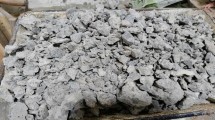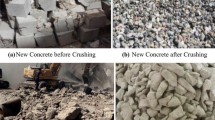Abstract
In present study, two different sizes i.e., gradation I and II, for both bituminous concrete (BC) and dense bituminous macadam (DBM) of aggregates are castoff to investigate the influence of gradation on four different shapes (i.e., round, angular, flaky and elongated). Subsequently, traditional methods and 3D optical scanner image analysis were infringed for morphological characteristics of the aggregates. In addition, scanning electron microscopy and energy dispersive X-ray spectroscopy analysis were carried out for determination of mineral composition and microstructure of aggregates. The results (from total 32 set of experiments as per factorial design) resolute that aggregate morphological characteristic is intensely associated with the resistance to permanent deformation of bituminous mixtures, and BC II and DBM II gradation represent better performance than BC I and DBM I. Furthermore, 3D optical scanner demonstrates a more direct and scientific evaluation of aggregate’s morphologic characteristics that present a superior relationship between the mixture performances than traditional techniques. It was found that the aggregate chemical composition, surface texture and filler microscopic morphological characteristics are highly associated with mechanical response and performance of bituminous mixtures.









Similar content being viewed by others
References
AASHTO (1989) Resistance of compacted asphalt mixtures to moisture-induced damage. American Association of State Highway and Transportation Officials, Washington DC
Abo-Qudais S, Al-Shweily H (2007) Effect of aggregate properties on asphalt mixtures stripping and creep behavior. Constr Build Mater 21:1886–1898
Aragão FT, Pazos AR, da Motta LM, Kim YR, do Nascimento LA (2016) Effects of morphological characteristics of aggregate particles on the mechanical behavior of bituminous paving mixtures. Constr Build Mater 123:444–453
Arasan S, Yenera E, Hattatoglu F, Hinislioglua S, Akbuluta S (2011) Correlation between shape of aggregate and mechanical properties of asphalt concrete: digital image processing approach. Road Mater Pavement 12:239–262
Asphalt Institute (2014) MS-2 asphalt mix design methods. Lexington Kentucky, USA
ASTM (1989) Resistance to plastic flow of bituminous mixtures using marshall apparatus. American Society for Testing and Materials, West Conshohocken
ASTM (2004) Standard test method for effect of moisture on asphalt concrete paving mixtures. American Society for Testing and Materials, West Conshohocken
ASTM (2012) Standard test method for indirect tensile (IDT) strength of bituminous mixtures. American Society for Testing and Materials, West Conshohocken
ASTM (2015) Standard test method for marshall stability and flow of asphalt mixtures. American Society for Testing and Materials, West Conshohocken
Breytenbach J, Anochie-Boateng JK, Paige-Green P, Van Rooy JL (2013) Laser-based assessment of road aggregate particle shape and texture properties with the aim of deriving comparative models. J S Afr Inst Civ Eng 55:30–35
Gao J, Wang H, Bu Y, You Z, Zhang X, Irfan M (2020) Influence of coarse-aggregate angularity on asphalt mixture macroperformance: skid resistance, high-temperature, and compaction performance. J Mater Civ Eng 32(5):04020095
Huyan J, Li W, Tighe S, Xu Z, Zhai J (2020) CrackU-net: A novel deep convolutional neural network for pixel-wise pavement crack detection. Struct Cont Health Monit 27(8):e2551
IRC 37 (2018) Guidelines for the design of flexible pavements, IRC:37–2018 Indian code of practice, New Delhi
IS (1976) Determination of sand equivalent value of soils and fine aggregates— part XXXVII. Bureau of Indian Standards, New Delhi
IS 2336 (1963) Methods of test for aggregates for concrete part 1 particle size and shape bureau of Indian Standards, New Delhi
IS 73 (2013) Paving bitumen—specification (Fourth Revision) Bureau of Indian Standards, New Delhi
Janoo V (1998) Quantification of shape, angularity, and surface texture of base course materials. Technical report, Cold Regions Research and Engineering Lab Hanover NH
Jin C, Yang X, You Z, Liu K (2018) Aggregate shape characterization using virtual measurement of three-dimensional solid models constructed from X-ray CT images of aggregates. J Mater Civil Eng. https://doi.org/10.1061/(ASCE)MT.1943-5533.0002210
Komba JJ, Anochie-Boateng JK, Merwe Steyn W (2013) Analytical and laser scanning techniques to determine shape properties of aggregates. Transport Res Rec 2335:60–71
Kuo CY, Freeman RB (1998) Image analysis evaluation of aggregates for asphalt concrete mixtures. Transport Res Rec 1615:65–71
Kuo CY, Frost JD, Lai JS, Wang LB (1996) Three-dimensional image analysis of aggregate particles from orthogonal projections. Transport Res Rec 1526:98–103
Kuo CY, Rollings RS, Lynch LN (1998) Morphological study of coarse aggregates using image analysis. J Mater Civil Eng 10:135–142
Liu Y, Nair H, Lane S, Wang L et al (2019) Influence of aggregate morphology and grading on the performance of 9.5-mm stone matrix asphalt mixtures. Virginia Transportation Research Council. https://rosap.ntl.bts.gov/view/dot/42362. Accessed 26 July 2019
Lugo A, Allex E, Mercado EA, Caro Spinel S (2008) X-ray computed tomography and aggregate image system (AIMS) for studying hot mix asphalt and aggregates. Ing Investig 28(2):142–151
Masad E, Olcott D, White T, Tashman L (2001) Correlation of fine aggregate imaging shape indices with asphalt mixture performance. Transport Res Rec 1757:148–156
Mitra K, Das A, Basu S (2012) Mechanical behavior of asphalt mix: an experimental and numerical study. Constr Build Mater 27:545–552
Pan T, Tutumluer E, Carpenter SH (2006) Effect of coarse aggregate morphology on permanent deformation behavior of hot mix asphalt. J Transport Eng 132:580–589
Wu J, Wang L, Meng L (2017) Analysis of mineral composition and microstructure of gravel aggregate based on XRD and SEM. Road Mater Pavement 18:139–148
Wu J, Wang L, Hou Y, Xiong H, Lu Y, Zhang L (2018) A digital image analysis of gravel aggregate using CT scanning technique. Int J Pavement Res Technol 11:160–167
Zhou C, Zhang M, Li Y, Lu J, Chen J (2019) Influence of particle shape on aggregate mixture’s performance: DEM results. Road Mater Pavement 20:399–413
Author information
Authors and Affiliations
Corresponding author
Appendix
Appendix
Abbreviations
-
1.
IS: Indian Standard
-
2.
IRC: Indian Road Congress
-
3.
MoRTH: Ministry of Road Transport and Highway
-
4.
AASTHO: The American Association of State Highway and Transportation Officials
-
5.
ASTM: American Society for Testing and Materials
-
6.
NMAS: Nominal maximum aggregate size
-
7.
BC: Bituminous concrete
-
8.
DBM: Dense bituminous macadam
-
9.
VG: Viscosity grade
-
10.
VA: Air voids
-
11.
VMA: Voids in mineral aggregates
-
12.
VFB: Voids filled with bitumen
-
13.
SEM: Scanning electron microscope
-
14.
EDS: Energy dispersive X-ray spectroscopy
-
15.
DIP: Digital image processing
Rights and permissions
About this article
Cite this article
Khairandish, M.I., Chopra, A., Singh, S. et al. Effect of Gradation and Morphological Characteristics of Aggregates on Mechanical Properties of Bituminous Concrete and Dense Bituminous Macadam. Iran J Sci Technol Trans Civ Eng 46, 293–307 (2022). https://doi.org/10.1007/s40996-021-00609-8
Received:
Accepted:
Published:
Issue Date:
DOI: https://doi.org/10.1007/s40996-021-00609-8




